《市场营销学》课程授课教案(双语)Chapter 7 Customer-Driven Marketing Strategy
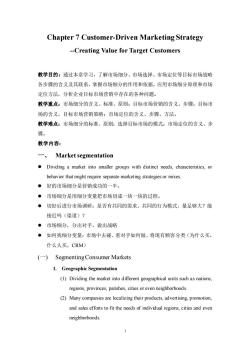
Chapter 7 Customer-Driven Marketing Strategy -Creating Value for Target Customers 教学目的:通过本章学习,了解市场细分、市场选择、市场定位等目标市场战略 各步骤的含义及其联系,掌握市场细分的作用和依据,应用市场细分原理和市场 定位方法,分析企业目标市场营销中存在的各种问题。 教学重点:市场细分的含义、标准、原则:目标市场营销的含义、步骤:目标市 场的含义,目标市场营销策略:市场定位的含义、步骤、方法。 教学难点:市场细分的标准、原则:选择目标市场的模式:市场定位的含义、步 骤。 教学内容: 一、Market segmentation Dividing a market into smaller groups with distinct needs,characteristics,or behavior that might require separate marketing strategies or mixes. ·好的市场细分是营销成功的一半。 ·市场细分是用细分变量把市场切成一块一块的过程。 ·切好后进行市场调研:是否有共同的需求、共同的行为模式、量足够大?能 接近吗(渠道)? ·市场细分,分出对手,做出战略 ·如何找细分变量:市场中去碰、看对手如何做、将现有顾客分类(为什么买, 什么人买,CRM (一)Segmenting Consumer Markets 1.Geographic Segmentation (1)Dividing the market into different geographical units such as nations. regions,provinces,parishes,cities or even neighborhoods. (2)Many companies are localizing their products,advertising.promotion, and sales efforts to fit the needs of individual regions,cities and even neighborhoods
1 Chapter 7 Customer-Driven Marketing Strategy -Creating Value for Target Customers 教学目的:通过本章学习,了解市场细分、市场选择、市场定位等目标市场战略 各步骤的含义及其联系,掌握市场细分的作用和依据,应用市场细分原理和市场 定位方法,分析企业目标市场营销中存在的各种问题。 教学重点:市场细分的含义、标准、原则;目标市场营销的含义、步骤;目标市 场的含义,目标市场营销策略;市场定位的含义、步骤、方法。 教学难点:市场细分的标准、原则;选择目标市场的模式;市场定位的含义、步 骤。 教学内容: 一、 Market segmentation ⚫ Dividing a market into smaller groups with distinct needs, characteristics, or behavior that might require separate marketing strategies or mixes. ⚫ 好的市场细分是营销成功的一半。 ⚫ 市场细分是用细分变量把市场切成一块一块的过程。 ⚫ 切好后进行市场调研:是否有共同的需求、共同的行为模式、量足够大?能 接近吗(渠道)? ⚫ 市场细分,分出对手,做出战略 ⚫ 如何找细分变量:市场中去碰、看对手如何做、将现有顾客分类(为什么买, 什么人买,CRM) (一) Segmenting Consumer Markets 1. Geographic Segmentation (1) Dividing the market into different geographical units such as nations, regions, provinces, parishes, cities or even neighborhoods. (2) Many companies are localizing their products, advertising, promotion, and sales efforts to fit the needs of individual regions, cities and even neighborhoods
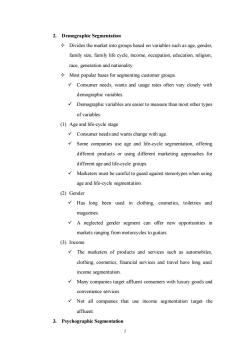
2.Demographic Segmentation Divides the market into groups based on variables such as age.gender. family size,family life cycle,income,occupation,education,religion race,generation and nationality. Most popular bases for segmenting customer groups. Consumer needs,wants and usage rates often vary closely with demographic variables Demographic variables are easier to measure than most other types of variables. (1)Age and life-cycle stage Consumer needs and wants change with age. Some companies use age and life-cycle segmentation,offering different products or using different marketing approaches for different age and life-cycle groups. Marketers must be careful to guard against stereotypes when using age and life-cycle segmentation. (2)Gender Has long been used in clothing.cosmetics,toiletries and magazines. A neglected gender segment can offer new opportunities in markets ranging from motorcycles to guitars (3)Income The marketers of products and services such as automobiles, clothing.cosmetics,financial services and travel have long used income segmentation Many companies target affluent consumers with luxury goods and convenience services Not all companies that use income segmentation target the affluent. 3.Psychographic Segmentation
2 2. Demographic Segmentation Divides the market into groups based on variables such as age, gender, family size, family life cycle, income, occupation, education, religion, race, generation and nationality. Most popular bases for segmenting customer groups. ✓ Consumer needs, wants and usage rates often vary closely with demographic variables. ✓ Demographic variables are easier to measure than most other types of variables. (1) Age and life-cycle stage ✓ Consumer needs and wants change with age. ✓ Some companies use age and life-cycle segmentation, offering different products or using different marketing approaches for different age and life-cycle groups. ✓ Marketers must be careful to guard against stereotypes when using age and life-cycle segmentation. (2) Gender ✓ Has long been used in clothing, cosmetics, toiletries and magazines. ✓ A neglected gender segment can offer new opportunities in markets ranging from motorcycles to guitars. (3) Income ✓ The marketers of products and services such as automobiles, clothing, cosmetics, financial services and travel have long used income segmentation. ✓ Many companies target affluent consumers with luxury goods and convenience services. ✓ Not all companies that use income segmentation target the affluent. 3. Psychographic Segmentation
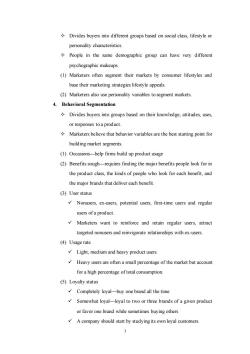
Divides buyers into different groups based on social class,lifestyle or personality characteristics. People in the same demographic group can have very different psychographic makeups. (1)Marketers often segment their markets by consumer lifestyles and base their marketing strategies lifestyle appeals. (2)Marketers also use personality variables to segment markets 4.Behavioral Segmentation Divides buyers into groups based on their knowledge,attitudes,uses. or responses toa product. Marketers believe that behavior variables are the best starting point for building market segments. (1)Occasions-help firms build up product usage (2)Benefits sough-requires finding the major benefits people look for in the product class,the kinds of people who look for each benefit,and the major brands that deliver each benefit. (3)User status Nonusers,ex-users,potential users,first-time users and regular users of a product. Marketers want to reinforce and retain regular users,attract targeted nonusers and reinvigorate relationships with ex-users (4)Usage rate Light,medium and heavy product users. Heavy users are often a small percentage of the market but account for a high percentage of total consumption (⑤)Loyalty status Completely loyal-buy one brand all the time Somewhat loyal-loyal to two or three brands of a given product or favor one brand while sometimes buying others A company should start by studying its own loyal customers. 3
3 Divides buyers into different groups based on social class, lifestyle or personality characteristics. People in the same demographic group can have very different psychographic makeups. (1) Marketers often segment their markets by consumer lifestyles and base their marketing strategies lifestyle appeals. (2) Marketers also use personality variables to segment markets. 4. Behavioral Segmentation Divides buyers into groups based on their knowledge, attitudes, uses, or responses to a product. Marketers believe that behavior variables are the best starting point for building market segments. (1) Occasions—help firms build up product usage (2) Benefits sough—requires finding the major benefits people look for in the product class, the kinds of people who look for each benefit, and the major brands that deliver each benefit. (3) User status ✓ Nonusers, ex-users, potential users, first-time users and regular users of a product. ✓ Marketers want to reinforce and retain regular users, attract targeted nonusers and reinvigorate relationships with ex-users. (4) Usage rate ✓ Light, medium and heavy product users. ✓ Heavy users are often a small percentage of the market but account for a high percentage of total consumption. (5) Loyalty status ✓ Completely loyal—buy one brand all the time ✓ Somewhat loyal—loyal to two or three brands of a given product or favor one brand while sometimes buying others ✓ A company should start by studying its own loyal customers
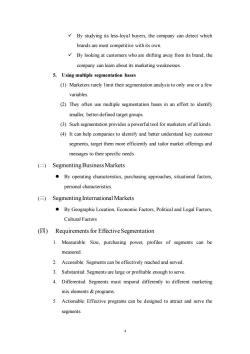
By studying its less-loyal buyers,the company can detect which brands are most competitive with its own. By looking at customers who are shifting away from its brand,the company can leam about its marketing weaknesses. 5.Using multiple segmentation bases (1)Marketers rarely limit their segmentation analysis to only one or a few variables (2)They often use multiple segmentation bases in an effort to identify smaller,better-defined target groups. (3)Such segmentation provides a powerful tool for marketers of all kinds. (4)It can help companies to identify and better understand key customer segments,target them more efficiently and tailor market offerings and messages to their specific needs. ()Segmenting Business Markets By operating characteristics,purchasing approaches,situational factors, personal characteristics. (=Segmenting International Markets By Geographic Location,Economic Factors,Political and Legal Factors, Cultural Factors (Requirements for Effective Segmentation 1.Measurable:Size,purchasing power,profiles of segments can be measured. 2.Accessible:Segments can be effectively reached and served. 3.Substantial:Segments are large or profitable enough to serve 4.Differential:Segments must respond differently to different marketing mix elements programs. 5.Actionable:Effective programs can be designed to attract and serve the segments
4 ✓ By studying its less-loyal buyers, the company can detect which brands are most competitive with its own. ✓ By looking at customers who are shifting away from its brand, the company can learn about its marketing weaknesses. 5. Using multiple segmentation bases (1) Marketers rarely limit their segmentation analysis to only one or a few variables. (2) They often use multiple segmentation bases in an effort to identify smaller, better-defined target groups. (3) Such segmentation provides a powerful tool for marketers of all kinds. (4) It can help companies to identify and better understand key customer segments, target them more efficiently and tailor market offerings and messages to their specific needs. (二) Segmenting Business Markets ⚫ By operating characteristics, purchasing approaches, situational factors, personal characteristics. (三) Segmenting International Markets ⚫ By Geographic Location, Economic Factors, Political and Legal Factors, Cultural Factors (四) Requirements for Effective Segmentation 1. Measurable: Size, purchasing power, profiles of segments can be measured. 2. Accessible: Segments can be effectively reached and served. 3. Substantial: Segments are large or profitable enough to serve. 4. Differential: Segments must respond differently to different marketing mix elements & programs. 5. Actionable: Effective programs can be designed to attract and serve the segments

二、Market Targeting (-)Evaluating Market Segments 1.Segment Size and Growth -Analyze current sales,growth rates and expected profitability for various segments 2.Segment Structural Attractiveness Consider effects of competitors,availability of substitute products and the power of buyers suppliers. 3.Company Objectives and Resources -Company skills&resources needed to succeed in that segment(s) Look for Competitive Advantages. ()Selecting Target Market Segments Target market-a set of buyers sharing common needs or characteristics that the company decides to serve. 1.Undifferentiated Marketing(mass marketing): (1)Same product toall consumers(no segmentation,i.e Coca-Cola) (2)Ignore market segment differences and target the whole market with one offer. (3)Focus on what is common in the needs of consumers. (4)Difficulties arise in developing a product or brand that will satisfy all consumers. (5)Mass marketers often have trouble competing with more-focused fimms that do a better job of satisfying the needs of specific segments and niches 2.Differentiated Marketing(segmented marketing) (1)Different products to one or more segments(some segmentation) (2)By offering product and marketing variations to segments,companies hope for higher sales and a stronger position within each market segment (3)But differentiated marketing also increases the costs of doing business
5 二、 Market Targeting (一) Evaluating Market Segments 1. Segment Size and Growth – Analyze current sales, growth rates and expected profitability for various segments. 2. Segment Structural Attractiveness – Consider effects of: competitors, availability of substitute products and, the power of buyers & suppliers. 3. Company Objectives and Resources – Company skills & resources needed to succeed in that segment(s). – Look for Competitive Advantages. (二) Selecting Target Market Segments Target market-a set of buyers sharing common needs or characteristics that the company decides to serve. 1. Undifferentiated Marketing (mass marketing): (1) Same product to all consumers (no segmentation, i.e Coca-Cola) (2) Ignore market segment differences and target the whole market with one offer. (3) Focus on what is common in the needs of consumers. (4) Difficulties arise in developing a product or brand that will satisfy all consumers. (5) Mass marketers often have trouble competing with more-focused firms that do a better job of satisfying the needs of specific segments and niches. 2. Differentiated Marketing (segmented marketing) (1) Different products to one or more segments(some segmentation) (2) By offering product and marketing variations to segments, companies hope for higher sales and a stronger position within each market segment. (3) But differentiated marketing also increases the costs of doing business
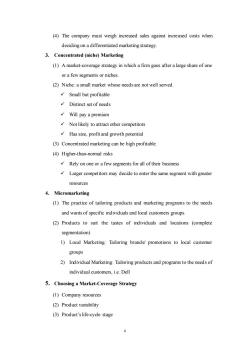
(4)The company must weigh increased sales against increased costs when deciding on a differentiated marketing strategy 3.Concentrated(niche)Marketing (1)A market-coverage strategy in which a firm goes after a large share of one or a few segments or niches. (2)Niche:a small market whose needs are not well served. Small but profitable √Distinct set of needs √Will pay a premium Not likely to attract other competitors Has size,profit and growth potentia (3)Concentrated marketing can be high profitable (4)Higher-than-normal risks Rely on one or a few segments for all of their business Larger competitors may decide to enter the same segment with greater resources 4.Micromarketing (1)The practice of tailoring products and marketing programs to the needs and wants of specific individuals and local customers groups. (2)Products to suit the tastes of individuals and locations (complete segmentation) 1)Local Marketing:Tailoring brands/promotions to local customer groups 2)Individual Marketing:Tailoring products and programs to the needs of individual customers,ie.Dell 5.Choosing a Market-Coverage Strategy (1)Company resources (2)Product variability (3)Product's life-cycle stage 6
6 (4) The company must weigh increased sales against increased costs when deciding on a differentiated marketing strategy. 3. Concentrated (niche) Marketing (1) A market-coverage strategy in which a firm goes after a large share of one or a few segments or niches. (2) Niche: a small market whose needs are not well served. ✓ Small but profitable ✓ Distinct set of needs ✓ Will pay a premium ✓ Not likely to attract other competitors ✓ Has size, profit and growth potential (3) Concentrated marketing can be high profitable. (4) Higher-than-normal risks ✓ Rely on one or a few segments for all of their business ✓ Larger competitors may decide to enter the same segment with greater resources 4. Micromarketing (1) The practice of tailoring products and marketing programs to the needs and wants of specific individuals and local customers groups. (2) Products to suit the tastes of individuals and locations (complete segmentation) 1) Local Marketing: Tailoring brands/ promotions to local customer groups 2) Individual Marketing: Tailoring products and programs to the needs of individual customers, i.e. Dell 5. Choosing a Market-Coverage Strategy (1) Company resources (2) Product variability (3) Product’s life-cycle stage

(4)Market variability (5)Competitors'marketing strategies 三、Differentiation and Positioning (一)Positioning 1.Definition:The way the product is defined by consumers on important attributes-the place the product occupies in consumers'minds relative to competing products 2.Marketers must: -Plan positions to give their products the greatest advantage in selected target markets, -Design marketing mixes to create these planned positions. 定位是给产品做一个与众不同的差异化 一定位是背后的意图,广告是定位的体现 一定位原则:要么第一,要么唯一 一定位是营销人员策划出来放进顾客脑子里的 一定位不同,结果不同 一定位不能轻易改变 重新定位:重新包装、策划,变成全新产品 一定位的传播原则:简单、重复、突出重点 ()Choosinga PositioningStrategy 1.Identifying Possible Competitive Advantages (1)Key to winning and keeping customers is to understand their needs and buying processes better than competitors do and deliver more value. (2)Competitive advantage is an advantage over competitors gained by offering consumers greater value,either through lower prices or by providing more benefits that justify competitive advantage
7 (4) Market variability (5) Competitors’ marketing strategies 三、 Differentiation and Positioning (一) Positioning 1. Definition: The way the product is defined by consumers on important attributes - the place the product occupies in consumers’ minds relative to competing products. 2. Marketers must: – Plan positions to give their products the greatest advantage in selected target markets, – Design marketing mixes to create these planned positions. – 定位是给产品做一个与众不同的差异化 – 定位是背后的意图,广告是定位的体现 – 定位原则:要么第一,要么唯一 – 定位是营销人员策划出来放进顾客脑子里的 – 定位不同,结果不同 – 定位不能轻易改变 – 重新定位:重新包装、策划,变成全新产品 – 定位的传播原则:简单、重复、突出重点 (二) Choosing a Positioning Strategy 1. Identifying Possible Competitive Advantages (1) Key to winning and keeping customers is to understand their needs and buying processes better than competitors do and deliver more value. (2) Competitive advantage is an advantage over competitors gained by offering consumers greater value, either through lower prices or by providing more benefits that justify competitive advantage

Product Differentiation Services Differentiation i.e.Features,Performance,Style&Desigr ie.Delivery,Installation,Repair Services orAttributes Customer Training Services Channel differentiation Personnel Differentiation Design their channel's coverage,expertise i.e.Hiring Training Better People Thar and performance Competitors Do Image Differentiation ie.Symbols,Atmospheres,Events 2.Choosing the Right Competitive Advantages (1)How many differences to promote USP(Unique Selling Proposition) More than one differentiator(necessary if two or more firms are claiming to be best on the same attribute) (2)Which differencesto promote Important-the differences delivers a highly valued benefit to target buyers Distinctivecompetitors do not offer the difference,or the company can offer it in a more distinctive way Superior-the difference is superior to other ways that customers might obtain the same benefit Communicable-the difference is communicable and visible to buyers Preemptive-competitors cannot easily copy the difference Affordable-buyers can afford to pay for the difference Profitable-the company can introduce the difference profitable. Choosing competitive advantages upon which to position a product or service can be difficult vet such choices may be crucial to success
8 Product Differentiation i.e. Features, Performance, Style & Design, or Attributes Services Differentiation i.e. Delivery, Installation, Repair Services, Customer Training Services Channel differentiation Design their channel’s coverage, expertise and performance Personnel Differentiation i.e. Hiring Training Better People Than Competitors Do Image Differentiation i.e. Symbols, Atmospheres, Events 2. Choosing the Right Competitive Advantages (1) How many differences to promote ✓ USP(Unique Selling Proposition) ✓ More than one differentiator (necessary if two or more firms are claiming to be best on the same attribute) (2) Which differences to promote ✓ Important—the differences delivers a highly valued benefit to target buyers ✓ Distinctive—competitors do not offer the difference, or the company can offer it in a more distinctive way ✓ Superior—the difference is superior to other ways that customers might obtain the same benefit ✓ Communicable—the difference is communicable and visible to buyers ✓ Preemptive—competitors cannot easily copy the difference ✓ Affordable—buyers can afford to pay for the difference ✓ Profitable—the company can introduce the difference profitable. Choosing competitive advantages upon which to position a product or service can be difficult, yet such choices may be crucial to success
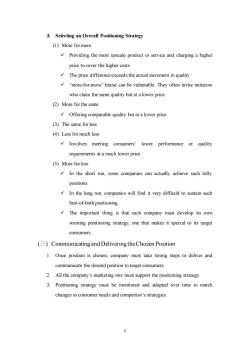
3.Selecting an Overall Positioning Strategy (1)More for more Providing the most upscale product or service and charging a higher price to cover the higher costs The price difference exceeds the actual increment in quality "more-for-more"brand can be vulnerable.They often invite imitators who claim the same quality but at a lower price (2)More for the same Offering comparable quality but at a lower price (3)The same for less (4)Less for much less Involves meeting consumers'lower performance or quality requirements at a much lower price. (5)More for less In the short run,some companies can actually achieve such lofty positions. In the long run,companies will find it very difficult to sustain such best-of-both positioning. The important thing is that each company must develop its own winning positioning strategy,one that makes it special to its target consumers ()Communicating and Deliveringthe Chosen Position 1.Once position is chosen,company must take strong steps to deliver and communicate the desired position to target consumers. 2.All the company's marketing mix must support the positioning strategy 3.Positioning strategy must be monitored and adapted over time to match changes in consumer needs and competitor's strategies
9 3. Selecting an Overall Positioning Strategy (1) More for more ✓ Providing the most upscale product or service and charging a higher price to cover the higher costs ✓ The price difference exceeds the actual increment in quality ✓ “more-for-more” brand can be vulnerable. They often invite imitators who claim the same quality but at a lower price. (2) More for the same ✓ Offering comparable quality but at a lower price (3) The same for less (4) Less for much less ✓ Involves meeting consumers’ lower performance or quality requirements at a much lower price. (5) More for less ✓ In the short run, some companies can actually achieve such lofty positions. ✓ In the long run, companies will find it very difficult to sustain such best-of-both positioning. ✓ The important thing is that each company must develop its own winning positioning strategy, one that makes it special to its target consumers. (三) Communicating and Delivering the Chosen Position 1. Once position is chosen, company must take strong steps to deliver and communicate the desired position to target consumers. 2. All the company’s marketing mix must support the positioning strategy. 3. Positioning strategy must be monitored and adapted over time to match changes in consumer needs and competitor’s strategies
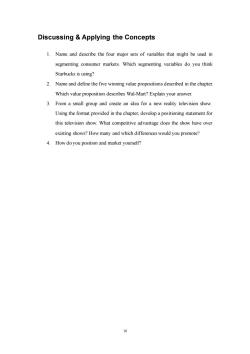
Discussing Applying the Concepts 1.Name and describe the four major sets of variables that might be used in segmenting consumer markets.Which segmenting variables do you think Starbucks is using? 2.Name and define the five winning value propositions described in the chapter. Which value proposition describes Wal-Mart?Explain your answer. 3.From a small group and create an idea for a new reality television show. Using the format provided in the chapter,develop a positioning statement for this television show.What competitive advantage does the show have over existing shows?How many and which differences would you promote? 4.How doyou position and market yourself?
10 Discussing & Applying the Concepts 1. Name and describe the four major sets of variables that might be used in segmenting consumer markets. Which segmenting variables do you think Starbucks is using? 2. Name and define the five winning value propositions described in the chapter. Which value proposition describes Wal-Mart? Explain your answer. 3. From a small group and create an idea for a new reality television show. Using the format provided in the chapter, develop a positioning statement for this television show. What competitive advantage does the show have over existing shows? How many and which differences would you promote? 4. How do you position and market yourself?
按次数下载不扣除下载券;
注册用户24小时内重复下载只扣除一次;
顺序:VIP每日次数-->可用次数-->下载券;
- 《市场营销学》课程授课教案(双语)Chapter 6 Business Markets and Business Buyer Behavior.doc
- 《市场营销学》课程授课教案(双语)Chapter 9 Pricing and Pricing Strategies.doc
- 《市场营销学》课程授课教案(双语)Chapter 10 Marketing Channels.doc
- 内蒙古科技大学:《市场营销学》课程授课教案(中文)第1章 营销与营销过程.doc
- 内蒙古科技大学:《市场营销学》课程授课教案(中文)第3章 营销系统与营销环境分析.doc
- 内蒙古科技大学:《市场营销学》课程授课教案(中文)第4章 消费者市场与购买行为分析.doc
- 内蒙古科技大学:《市场营销学》课程授课教案(中文)第2章 顾客价值与顾客满意.doc
- 内蒙古科技大学:《市场营销学》课程授课教案(中文)第9章 市场传播与促销.doc
- 内蒙古科技大学:《市场营销学》课程授课教案(中文)第10章 产品生命周期与营销战略.doc
- 内蒙古科技大学:《市场营销学》课程授课教案(中文)第6章 产品决策.doc
- 内蒙古科技大学:《市场营销学》课程授课教案(中文)第5章 市场细分、决定目标市场与定位.doc
- 内蒙古科技大学:《市场营销学》课程授课教案(中文)第7章 价格策略.doc
- 内蒙古科技大学:《市场营销学》课程授课教案(中文)第8章 分销管理.doc
- 内蒙古科技大学:《市场营销学》课程教学资源(试卷习题)2013-2014第二学期试卷A(答案).doc
- 内蒙古科技大学:《市场营销学》课程教学资源(试卷习题)2013-2014第二学期试卷A(试题).doc
- 内蒙古科技大学:《市场营销学》课程教学资源(试卷习题)2012-2013第二学期试卷B(答案).doc
- 内蒙古科技大学:《市场营销学》课程教学资源(试卷习题)2012-2013第二学期试卷B(试题).doc
- 内蒙古科技大学:《市场营销学》课程教学资源(试卷习题)2012-2013第一学期试卷A(答案).doc
- 内蒙古科技大学:《市场营销学》课程教学资源(试卷习题)2012-2013第一学期试卷B(答案).doc
- 内蒙古科技大学:《市场营销学》课程教学资源(试卷习题)2012-2013第一学期试卷B(试题).doc
- 《市场营销学》课程授课教案(双语)Chapter 8 Products, Services, and Brands.doc
- 《市场营销学》课程授课教案(双语)Chapter 11 Communicating Customer Value.doc
- 《市场营销学》课程授课教案(双语)Chapter 2 Company and Marketing Strategy.doc
- 《市场营销学》课程授课教案(双语)Chapter 4 Managing Marketing Information to Gain Customer Insights.doc
- 《市场营销学》课程授课教案(双语)Chapter 5 Consumer Markets and Consumer Buyer Behavior.doc
- 《市场营销学》课程授课教案(双语)Chapter 3 Analyzing the Marketing Environment.doc
- 《市场营销学》课程授课教案(双语)Chapter 1 Marketing.doc
- 《市场营销学》课程教学案例(中文)第8章案例 分销渠道策略-通用公司打造全球供应链.doc
- 《市场营销学》课程教学案例(中文)第9章案例 促销策略-中国肥皂泡戏煞东瀛人.doc
- 《市场营销学》课程教学案例(中文)第6章案例 产品决策-广东太阳神的产品组合.doc
- 《市场营销学》课程教学案例(中文)第7章案例 价格决策-海信空调的价格策略.doc
- 《市场营销学》课程教学案例(中文)第5章案例 市场细分、决定目标市场与定位- “红高粱”的启示.doc
- 《市场营销学》课程教学案例(中文)第3章案例 市场营销环境-恒伟药业信息调研出效益.doc
- 《市场营销学》课程教学案例(中文)第4章案例 分析消费者市场与购买行为-小阿华的“精确营销”.doc
- 《市场营销学》课程教学案例(中文)第2章案例 规划企业战略与市场营销管理-雅戈尔,选择没有对错.doc
- 《市场营销学》课程教学案例(中文)第1章案例 营销与营销管理-亚马逊名震全球之道.doc
- 《市场营销学》课程教学案例(双语)The Pepsi and Coca-Cola Challenge-A Cola with Breakfast.doc
- 《市场营销学》课程教学案例(双语)Van Der Steen Candy Company.doc
- 《市场营销学》课程教学案例(双语)Summit Ski Produc.doc
- 《市场营销学》课程教学案例(双语)Who will go to Saudi Arabia.doc
